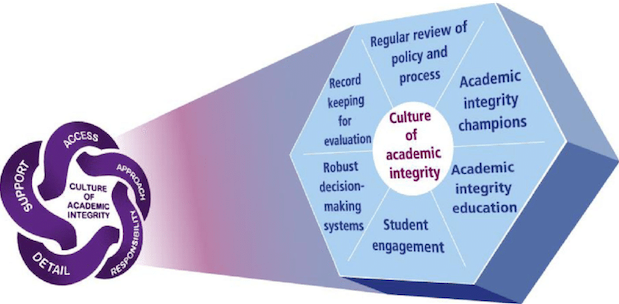Forward Steps for Academic Integrity and Record-keeping
Building and maintaining a streamlined record-keeping process at USask.
USask Academic Leadership Series
The Academic Integrity Task Force (2021-2022) strongly recommended the implementation of a streamlined record keeping process for academic misconduct decisions that could be appropriately and easily consulted by College leaders when needed. Appropriate record keeping and access is a recognized best practice among experts in the field and we are making progress on implementation at USask.

A conceptual framework of an exemplary academic integrity policy (Bretag & Mahmud, 2015, p. 473)
Why was this a recommendation?
USask regulations direct Colleges to handle cases of academic misconduct that come forward in their courses. Since students’ course registration often span Colleges, the capacity to check for prior findings concerning an individual student in a timely and appropriate way between Colleges is important. Record keeping can also facilitate consistent responses and tracking of trends and issues in our programs and the institution—helping us all manage risk.
What happened next?
A small team (Governance Office, Office of Teaching and Learning, Arts and Science, and ICT) examined options and found that USask already had a license to use a recommended platform called Maxient. Existing USask users of Maxient have had positive experiences and it allows customizable academic misconduct reporting and management of administrative records.
Now what?
Work is underway to develop the reporting form and internal routing mechanisms of the tool. The Governance Office is aiming to pilot Maxient with the College of Arts and Science in the spring.
What can you look forward to as a leader?
A tool that allows you to:
- Direct instructors to an online form for reporting suspected cases of academic misconduct that asks for specific information and allows for course syllabi, assessment details, and evidence of alleged academic misconduct to be attached.
- Receive allegations in a more consistent format that includes the details you are most likely to need
- Check whether the student has had a prior finding of academic misconduct at USask (to an appropriate level of detail).
- Advise an instructor, through the reporting system whether the matter should be pursued as academic misconduct, and if yes, whether to attempt an informal resolution or refer it on to the formal resolution of a hearing.
- Use templates that can be populated from an existing record to create agreements for informal resolutions and decision documents for hearings.
- Seek special reports for specific needs such as trends in your college context and precedents for similar or comparable cases.
- Ensure appropriate record retention and time limits.
What might a leader be thinking about now, in anticipation?
- What is the specific information I need in my College when I check for prior findings of academic misconduct for a student with a new allegation?
- What will it take to add records of prior findings (informal and formal) in my College from the last 5 years to Maxient, when it is ready?
- How may having access to information and reports in Maxient help my College with timely resolutions and with thinking about our approaches to progressive discipline?
- What kinds of tracking of trends would inform my College’s practices when it comes to teaching students what is expected, designing assessments, and securing assessments?
Title image credit: Image edited in Canva with permission - Original image by Supatman / Getty Images for Canva

